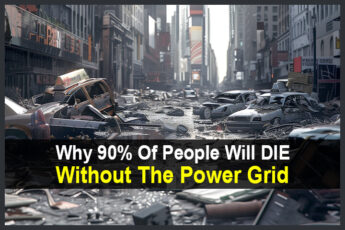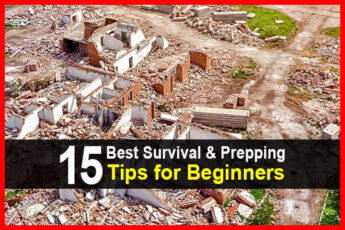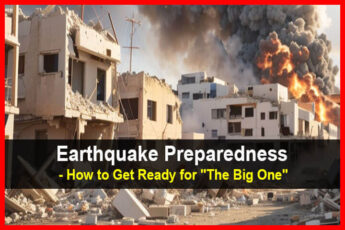Estimated reading time: 9 minutes
Bracing for winter's cold bite becomes a high-stakes endeavor during a blackout, a time when traditional heating systems may fail. Awareness and preparedness are critical in these situations as winter blackouts carry considerable risks, from hypothermia to frostbite. This article explains 11 of the best heating options to keep you safe and warm during these trying times.
Want to save this post for later? Click Here to Pin It On Pinterest!
1. Wood-Burning Stoves
Wood-burning stoves, a perennial favorite for off-grid heating, operate by burning wood to generate heat. The combustion process is straightforward: as wood burns, it releases heat, radiating warmth into your living space. With no need for electricity, wood-burning stoves are invaluable during blackouts.
However, their use isn't without drawbacks. Wood-burning stoves require a constant supply of wood, which may be challenging to procure in an emergency. There's also the risk of accidental fires if the chimney or stove is not properly maintained.
Ensure the stove is installed by a professional, and maintain a clear area around it to prevent accidental fires. If you're doing a DIY installation, just be sure to put a buffer of sheet metal around your stove to prevent excess heat from causing a fire.
Regular chimney cleaning is also essential to prevent the build-up of soot and creosote, which can cause chimney fires. It's probably a good idea to have a functioning battery-powered smoke detector and carbon monoxide detector nearby. The carbon monoxide detector should be kept at ground level as CO likes to fall to the ground.
2. Portable Indoor Propane Heaters
Portable indoor propane heaters are a convenient and efficient heating option, especially during a blackout. These units are powered by propane gas, which is readily available, even during power outages. They can quickly heat up small to medium-sized rooms, providing a cozy refuge from the winter cold.
One significant advantage of portable propane heaters is their independence from the power grid. They are also easy to use, with most models equipped with adjustable heat settings and automatic shut-off features for safety. However, there are potential drawbacks: they can deplete oxygen levels in a room and emit carbon monoxide, a dangerous, odorless gas.
Safety should always be a priority when using a portable indoor propane heater. Maintaining good airflow and ventilation will avoid carbon monoxide poisoning. Luckily, propane has an additive that people associate with rotten eggs that is easily detectable.
Never leave the heater unattended, and keep flammable materials away from the heater to prevent fires. As with a wood stove, it's advisable to install a battery-powered carbon monoxide detector in the area where you're using the heater.
3. Kerosene Heaters
Kerosene heaters are another practical option for heating during power outages. They operate using kerosene fuel, which can be stored for long periods and is therefore available during blackouts.
These heaters generate heat by burning the fuel in a wick, creating a warm and comfortable environment in small to medium-sized rooms. The main advantage of kerosene heaters is their portability and ability to light without electricity, making them a reliable source of heat in emergencies.
However, there are downsides to consider: they can emit fumes and also deplete the oxygen level in a room if improperly ventilated. Adequate ventilation is critical to prevent the build-up of harmful fumes.
It's also crucial not to leave the heater unattended and to keep it away from flammable materials to prevent accidental fires.
4. Gas Catalytic Heaters
Gas Catalytic heaters operate by flowing gas over a catalyst, a material that creates a chemical reaction without undergoing any change itself. This reaction occurs at a lower temperature than typical combustion, making it more energy-efficient and reducing harmful emissions.
The reaction generates heat, which is then radiated outwards. Unlike many other heaters, catalytic heaters do not require electricity to function, making them an ideal choice during power outages.
The main advantage of these heaters is their high efficiency. They convert nearly all the fuel into heat, reducing waste and operating costs. However, they do have drawbacks. They require a continuous supply of gas, which may not be readily available during a blackout.
When using a gas catalytic heater, you may have to crack a window open to get some ventilation to prevent the build-up of harmful gasses. Never leave this heater unattended, and keep combustible materials away from it to reduce the risk of fires.
5. Fireplace Inserts
Fireplace inserts are specially designed units that fit into pre-existing fireplaces, enhancing the heat output and overall efficiency. They function without electricity, making them a feasible option during blackouts. By harnessing the power of wood or gas, these inserts distribute heat more uniformly throughout the room compared to traditional fireplaces.
The primary advantage of fireplace inserts is their energy efficiency. They convert a higher amount of fuel into heat, minimizing waste and reducing heating costs. However, they require a steady supply of wood or gas, which could be a limiting factor during a prolonged blackout. Furthermore, incomplete combustion can lead to the build-up of harmful gasses.
Ventilation is again critical to prevent carbon monoxide build-up. Make sure there's a protective screen in front of the fire to prevent accidental sparks and burns.
6. Biofuel Cans
Biofuel cans provide another feasible heating alternative during power outages. They work by storing liquid biofuel, typically ethanol, in a safe, sealed container. When ignited, the biofuel burns cleanly, emitting heat.
The main benefit of biofuel cans is their portability and ease of use. They require no electricity and emit a substantial amount of heat for their size. Biofuels are also renewable, making this a more sustainable heating option. However, their small size also means they may not heat larger spaces efficiently.
Safety when using biofuel cans is paramount. Always ignite the biofuel can in a well-ventilated area to prevent the accumulation of harmful fumes. Furthermore, never leave a lit biofuel can unattended, and ensure it's out of reach of children and pets. Since these cans will get hot, refilling a hot or still burning can cause dangerous spills and burns.
7. Soapstone Heaters
Soapstone heaters provide an elegant and efficient heating solution during power outages. Made from natural soapstone, these heaters are renowned for their excellent heat retention and distribution abilities.
The premise is simple: The heat from burning wood or other fuels is absorbed by the soapstone and then gradually released into the room over a prolonged period, ensuring a steady, comfortable temperature.
While soapstone heaters offer a renewable and efficient heating source, they are not without disadvantages. The initial cost of installation can be high, and they require a considerable amount of space. Moreover, the soapstone takes time to heat up, which may not be ideal during sudden blackouts.
To effectively use a soapstone heater, ensure it is appropriately sized for your space, and regularly maintain it to prolong its efficiency. Do not overload it with fuel and allow sufficient time for the stone to heat up and distribute warmth.
8. Hand Warmers
Hand warmers are a compact and portable heating solution ideal for power outages, providing immediate warmth for up to several hours. These pocket-sized devices, typically filled with iron filings, generate heat through an exothermic reaction when exposed to oxygen. They're non-toxic, eco-friendly, and require no electricity.
Hand warmers offer instant relief from the cold, and their small size allows them to be used anywhere—whether you're indoors or outside. However, their heat is limited and may not suffice for prolonged power outages or severely cold conditions.
When choosing hand warmers, consider the duration of heat they promise and ensure they are air-activated. To use them effectively, shake the package to mix the contents, then open it to expose the warmer to air. Remember, while they are safe, they should not be placed directly against the skin for extended periods to prevent possible burns.
9. Candle Heaters
Candle heaters, specifically those utilizing clay pots and tea lights, are a simple and cost-effective solution for generating heat during power outages. The concept involves using the heat generated by a lit tea light candle to warm a clay pot, which then radiates the heat into the surrounding environment.
To create a candle heater, follow these steps:
- Place 1-3 tea light candles on a stable, well-insulated surface.
- Light the candle and place a small, unglazed clay pot over it, ensuring the pot has a hole at the top for ventilation.
The trapped heat will gradually radiate from the larger pot, warming the surroundings. Having multiple pots around the room will contribute to maintaining a warm temperature. You can even add an upright clay pot to the overturned one to radiate more heat.
Despite their simplicity, candle heaters must be used with caution. Always place them on a non-flammable surface away from combustible materials. Never leave a candle heater unattended. Monitor the temperature of the clay pot to prevent overheating by periodically hovering your hand over the pot. Let the heater cool down completely before handling.
10. Creating a Warming Room
This one is more of an effective strategy, a “warming room” is a designated area within a house or building designed to retain heat during a power outage. The concept is to concentrate heat sources in a single, well-insulated room to maximize warmth and conserve energy.
To create a warming room, choose a room with few windows, ideally in the interior of your home. Seal any drafts with towels or draft snakes and cover windows with blankets or thermal curtains. Use sleeping bags and blankets to capture your body heat for warmth.
By focusing heat on a single, well-sealed room, you can maintain a comfortable temperature in a power outage, reducing the risk of hypothermia and providing a safe, warm space for your household. When setting up and using a warming room, remember to regularly monitor the temperature and ventilation, ensuring a safe, comfortable environment.
Be Proactive and Insulate Your Home
Proper home insulation is a solid line of defense in retaining heat during a power outage. It acts as a thermal barrier, limiting the escape of warmth to the cold outdoors, thereby preserving the indoor temperature. It may also reduce strain on backup heating systems, extending their operational lifespan and conserving valuable energy resources during a blackout.
It’s best to start by insulating your walls, roof, and floors as they are the primary areas through which heat escapes. Use materials like spray foam, fiberglass, or cellulose for this purpose. Don't overlook windows and doors; use draft snakes, thermal curtains, or window insulation film to prevent heat loss.
An excellent idea is to use an infrared camera to look at the outside of your home to identify cold spots that need some attention.
Insulating pipes is also essential, particularly in colder climates. It prevents water in pipes from freezing, which could lead to pipe bursts. Pipe insulation materials like foam or rubber pipe wraps are easy to install and readily available in home improvement stores.
Conclusion
The best heating options during a winter blackout encompass setting up a warming room, adopting an effective home insulation strategy, and having multiple heating sources available. These measures are crucial in preserving warmth, conserving energy, and safeguarding your household from potential hazards.
Like this post? Don't Forget to Pin It On Pinterest!









